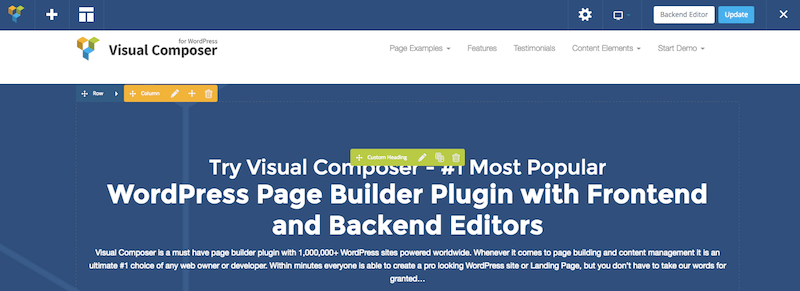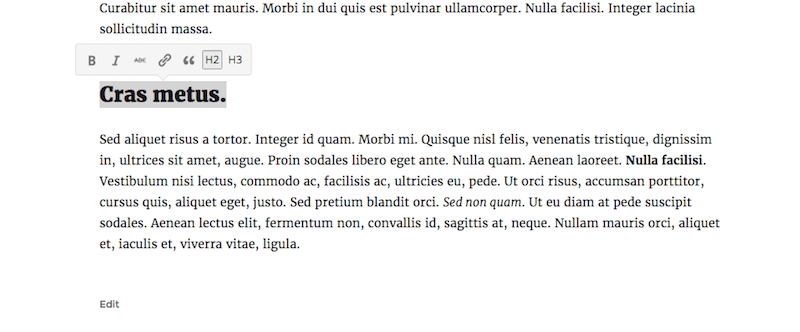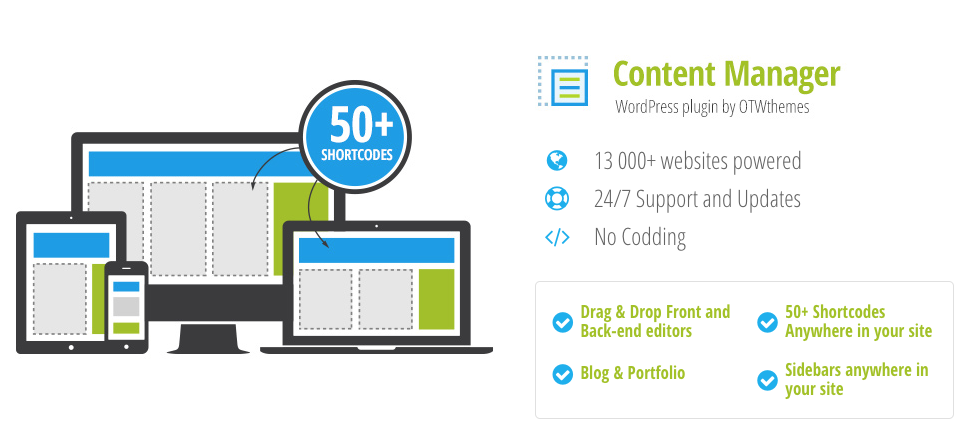Una gran razón de la popularidad de WordPress es su interfaz de administración fácil de usar. A pesar de todo, para algunos usuarios (sobre todo persons no técnicas), crear publicaciones y páginas usando el panel de WordPress puede ser abrumador.
Por suerte, hay muchos complementos de user interface de WordPress disponibles, que ofrecen a aquellos con menos conocimientos técnicos una forma de crear contents y personalizar diseños sin siquiera tocar la parte de atrás de WordPress.
In this post, we'll look at a number of useful plugins, for designing and editing content, and we'll give you the pros and cons of each one. In the end, you will have a solid idea about which plugins are right for you. Let us begin!
Front page layout plugins
Los complementos de diseño de página frontal le brindan un control total sobre el diseño de su sitio Web. Mientras tu can Use them to add and edit content, while allowing you to add layout items such as rows and columns, as well as other content items, such as sliders. Let's take a look at three of the favorites.
1. WPBakery (previously known as Visual Composer, included with Total WP Theme)

WPBakery Page Builder (previously Visual Composer) is probably one of the most popular page builder plugins for WordPress. For just $ 45, you can add this powerful plugin to your website. Or you could consider a premium theme that includes Visual Composer. Some themes, like the Total WordPress Theme, include additional page item modules and customizations as part of their package, giving you even more build options.
Cambiar entre los editores de la interfaz y el back-end de Visual Composer es fácil: simplemente haga clic para cambiar el diseño de la cuadrícula, agregar filas y columnas, posteriormente arrastre los items de contenido a la página, reorganizándolos según be necesario. Todos los items al mismo tiempo tienen múltiples opciones y variaciones para personalizar el aspecto y la funcionalidad de su página.
Need help getting started with Visual Composer? Check out our definitive guide to Visual Composer that walks you through the entire installation, setup, and page creation process.
Key features
- Over 45 drag-and-drop content items
- More than 150 third-party plugins available
- More than 60 predesigned designs
- Pros: Easy to use, live preview, compatible with most WordPress themes
- Cons: May have a bit of a learning curve, usually requires theme plugins or plugins for additional functionality
Get the WPBakery page builder
2. Elementor (free)
(*9*)
Cuando se trata de una página gratuita y una opción de creación de contenido, Elementor seguramente viene a la mente. Este poderoso complemento viene cargado con items útiles para la creación de contenido, como columnas, headers, imágenes, espaciado, listas y otras características clave que tal vez desee agregar a sus publicaciones. El complemento al mismo tiempo incluye plantillas prediseñadas que puede usar para un inicio aún más rápido, así como la opción de CSS personalizado (para ajustes de estilo).
Para aquellos que son expertos en código, Elementor está bien construido y es de Open Source. Entonces, si desea hacer algunos cambios y compartir, siéntase libre (aunque es bastante sólido, por lo que esto es más si necesita una solución personalizada).
Key features
- 23 free building blocks
- +24 more professional building blocks
- Easy to use preformatted templates
- Translation ready
- Pro: Easy to use, Quick start templates, Compatible with most themes
- Cons: The best features are available with Pro (so you'll want to upgrade)
Download Elementor Builder
3. MotoPress content editor (free)

MotoPress's free content editor enables you to create websites visually by dragging and dropping content items. Used on over 10,000 websites, the plugin has a 4.8-star satisfaction rating, making it worthy of your consideration. At the same time there is a premium version of the plugin available, which adds additional content items and premium support.
Even though MotoPress Content Editor is very easy to use, the plugin will only work with newly created pages, rather than your existing content. You can learn even more about this plugin in our MotoPress builder review.
Key features
- Over 30 items of drag and drop content
- Extensible through plugins
- Predesigned designs
- Pros: Extremely simple to use, live previews available, free
- Cons: Doesn't work with existing content
Get the MotoPress content editor
4. Live Composer (free)

Live Composer is a home page builder with drag and drop editing. It's used on over 10,000 websites and has a 4.8-star satisfaction rating, so it's worth checking out.
Enable the editor by clicking on the green Activate editor onto your page, which later enables you to drag and drop items onto the page. All in all, it is easy to use and all items can be fully customized in terms of style and functionality.
Key features
- Over 30 items of drag and drop content
- Import and export sections or designs
- Pros: Easy to use, live preview, free, no shortcodes used to create items
- Cons: Cannot be used with existing content, add custom post types on install
Front-end content editing plugins
While the above selection of plugins makes it possible for you to edit their content and their layouts, front-end content editing plugins are a bit more limited. Simply put, these plugins Allow users to update text, images, and other content. of your posts and pages without using the WordPress dashboard. Let's take a look at three of the best out there.
1. Editus (previously Lasso)
(*9*)
Editus was originally known as Lasso, and it comes to us from the people behind the Aesop story engine (PLAZA BURSÁTIL NORTEAMERICANA). It is an interface editor that allows you to see your changes in real time. From $ 99 to use on up to three sites, Editus is a powerful tool.
Using Editus is simple and is accessed with one click from a small toolbar that is displayed above your posts and pages. From there, selecting the relevant content displays a formatting toolbar for further editing.
Key features
- Real-time editing of text, links, images and other content.
- Featured Image Support
- Works on both posts and pages
- Compatible with multiple sites
- Pros: Easy to use interface, can be extended through ASE plugins, compatible with most themes
- Cons: Relatively expensive
2. Interface editor (free)

Formatting text is easy with the Interface Editor plugin.
The front-end editor was originally developed as a feature plugin for possible inclusion in the WordPress core. Even though that no longer seems to be the plan, the add-on is still available for use; at last count, there were over 2,000 installs, with a 4.2-star satisfaction rating.
Front-end Editor es fácil de usar, sin necesidad de configuración después de la instalación. Una vez activado, un Username con permisos de edición que visite cualquier publicación o página de su sitio web puede utilizar tanto Edit page link in the toolbar at the top of the screen, and a Edit link below content to allow editing.
Key features
- Real-time editing of text and links.
- Featured Image Support
- Works on both posts and pages
- Pros: Easy to use interface, Free
- Cons: Limited functionality (for example, cannot edit images), does not work with all themes
3. Content manager for WordPress

Con OTW Content manager para WordPress, puede crear rápidamente diseños receptivos para sus publicaciones y páginas. Utilice opciones para estilos personalizados, más de 50 códigos cortos para crear páginas fácilmente, editar el front-end (desde luego) e incluso crear sus propios códigos cortos personalizados para usar. Simplemente inserte los códigos cortos de creación de páginas, arrástrelos y suéltelos en su lugar, realice ediciones de estilo rápidas sobre la marcha y posteriormente publíquelas. ¡Es fácil!
For more options, Content Manager can be stacked with other OTW plugins, such as Sidebar & Widget Manager or Portfolio Manager Pro.
Key features
- 50+ shortcodes
- Edición de front y back end
- Bars laterales personalizables
- Pros: Easily expands with other OTW plugins
- Cons: Outdated UI design
Get the Content Manager for WordPress
4. Frontier Post (gratuito)

Frontier Post is a free plugin designed to allow full post management from the front of your website. It goes beyond just editing post content, allowing users with the proper permissions to create and delete posts. The plugin is currently being used on over 2,000 active websites and has a 4.9 star satisfaction rating.
With the plugin, administrators can control how and when posts are edited, as well as what options are available to users in the interface. At the same time, you have full control over Frontier Post user permissions. The standard Edit The links open the Frontier interface, which is a text editor identical to the WordPress TinyMCE editor. At the same time you can preview your post before publishing.
Key features
- Ability to edit text, links, images and more
- Featured Image Support
- Works on posts, pages, and custom post types
- Ability to add categories and tags
- Pros: Free, configurable, familiar WordPress editor interface
- Cons: No live preview
5. Gutenberg (free)

Lastly, we had to mention Gutenberg. This free content management plugin will soon be integrated into the WordPress core, so now is a great time to give it a try. In essence, Gutenberg is identical to many other content and page creators. There are included blocks that you can insert to create the layout you want.
Key features
- Simple content blocks
- Backward compatibility
- Pros: Free and will soon be basic
- Cons: Not as intuitive as other builders
conclusion
Even though the WordPress admin interface is designed to be easy to use, many non-technical users still find it complicated. Using plugins that allow users to create and edit site content from the interface, rather than the WordPress dashboard, simplifies the process and reduces stress for those navigating an unfamiliar environment.
We'd love to hear about your experiences with WordPress plugin editing, so share your tips and tricks in the comment section below.






